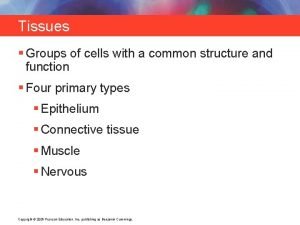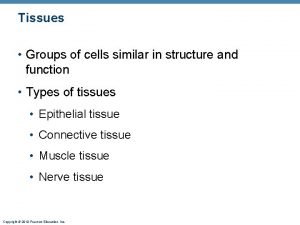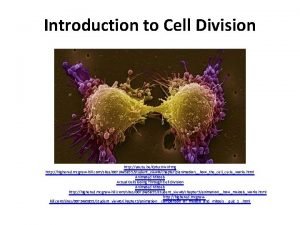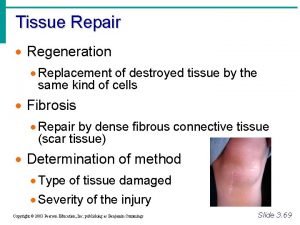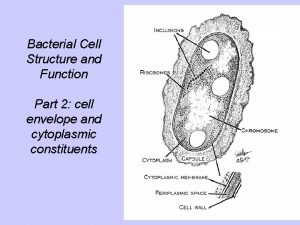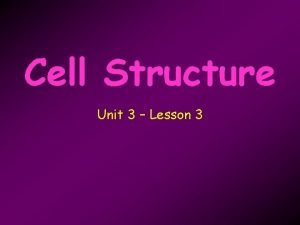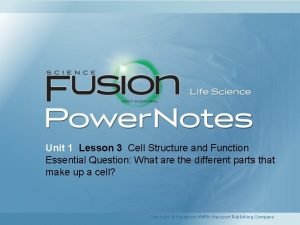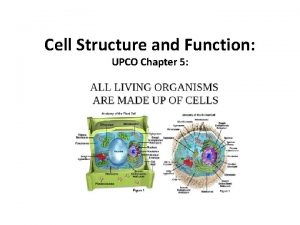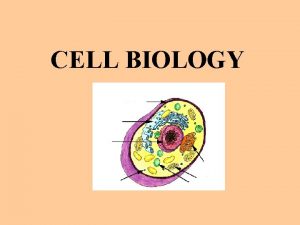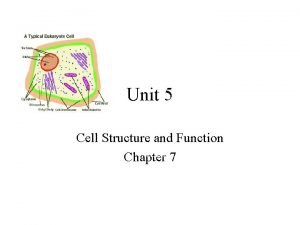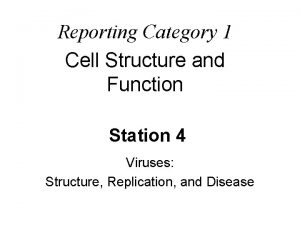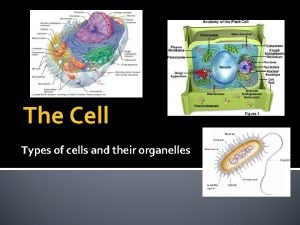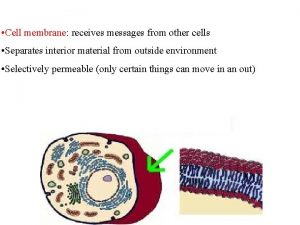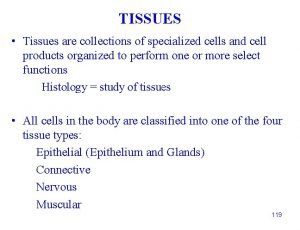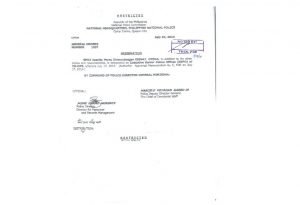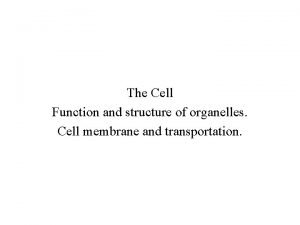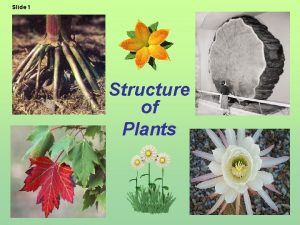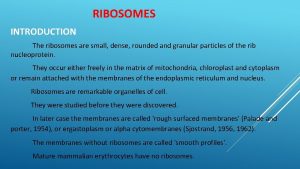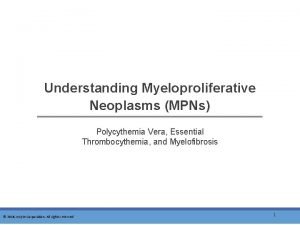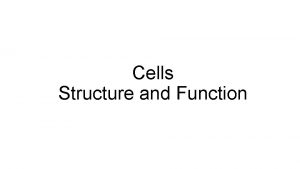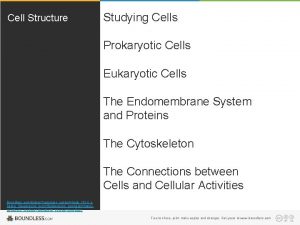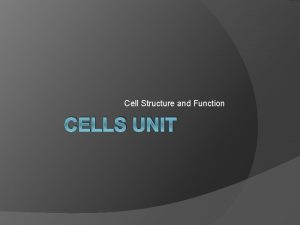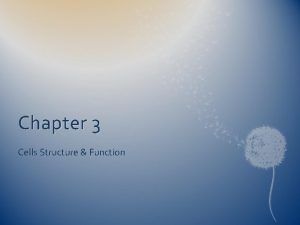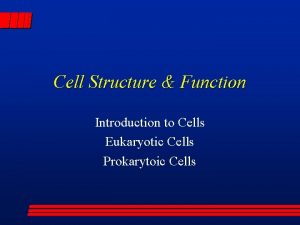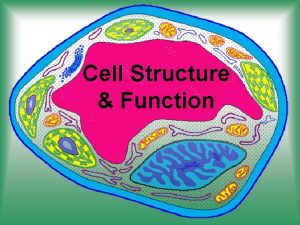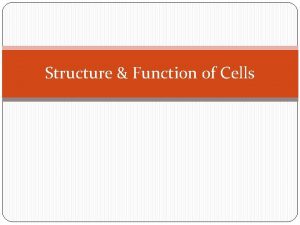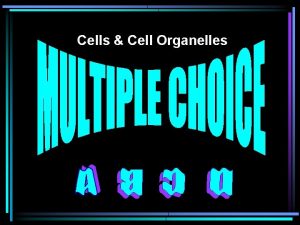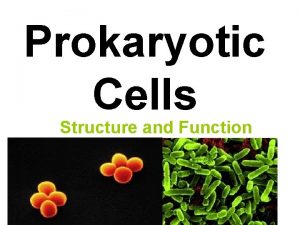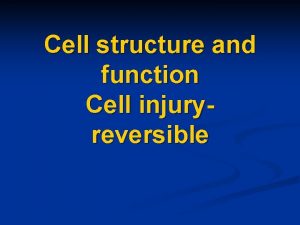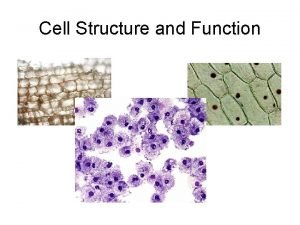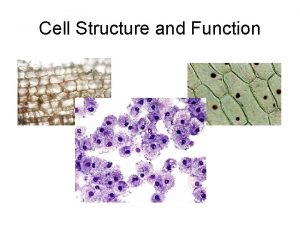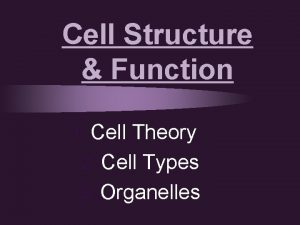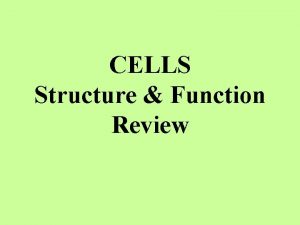CELLS Structure Function Review Which kind of cell












































- Slides: 44

CELLS Structure & Function Review

Which kind of cell is the largest? animal cell plant cell Bacteria Plant cells are the biggest What do we call membranes that allow certain molecules to pass through but not others? Selectively permeable OR semi-permeable

Which kind of cell is the smallest? animal cell plant cell Bacterial cells are the smallest Which molecule found in cell membranes helps cells “recognize self” ? glycoproteins

Cell membranes are made of these 2 main kinds of molecules. Phospholipids & proteins Which cell organelles burn glucose and store energy as ATP? mitochondria

Phospholipids form bilayers in cell membranes because their tails are trying hydrophobic _______ to stay away from water. Name a cell part with a DOUBLE MEMBRANE around it Nucleus, mitochondria, chloroplasts

What is the dark spot in the nucleus called? nucleolus What do we call DNA that is TIGHTLY PACKED in DIVIDING CELLS? chromosomes

What is the gel-like material and organelles called inside the cell membrane? cytoplasm What do we call DNA that is SPREAD OUT in NON-DIVIDING CELLS? chromatin

What are the folded membranes inside mitochondria called? cristae Which organelle looks like a “stack of pancakes”? GOLGI body

http: //faculty. clintoncc. suny. edu/faculty/Michael. Gregory/files/Bio%20101%20 Lectures/Membranes/membrane. htm Tell what this molecule does “self” identification Tell what this molecule does Store and transfer energy

Which part of a phospholipid is HYDROPHILIC? head tails Heads are hydrophilic TRUE or FALSE ALL CELLS have a cell membrane TRUE, plant, animal, and bacterial cells all have a CELL membrane

Which part of a phospholipid is HYDROPHOBIC? head tails Tails are hydrophobic TRUE or FALSE ALL CELLS have a nuclear membrane FALSE; only plant and animal cells (eukaryotes) have a NUCLEAR membrane. NOT bacteria (prokaryotes)

Tell which part does it? Burns glucose & stores energy as ATP _________ Mitochondria Controls what enters or leaves the cell _________ Cell membrane Sort & package substances Golgi bodies for transport out of cell _________ Makes ribosomes ___________ nucleolus Control center of cell __________ nucleus

Name this organelle Mitochondria What does it do? Powerplant of cell; Burn glucose and store energy as ATP

Name this molecule found in cell membranes phospholipid http: //biology. clc. uc. edu/courses/bio 104/cells. htm

Name this cell part http: //www. beyondbooks. com/lif 71/4 a. asp centrioles Name this molecule found in cell membranes Pull chromosomes apart

Smooth _____ ER does NOT have ribosomes attached Organelle in a plant or animal cell that contains the cell’s genetic material. nucleus

The blue part of this phospholipid molecule stays inside the membrane away from water because it is hydrophobic _______. hydrophilic hydrophobic

Cell suicide for the good of the organism is called ______ APOPTOSIS Cells that have a nuclear membrane and membranes around their organelles are called ________ eukaryotes

Name the sacs found inside chloroplasts that contain the molecules for photosynthesis thylakoids Centrioles are only found in ANIMAL cells ____ plant animal bacteria

Name this part. Smooth ER Tell what it does? Make lipids/steroids; Regulate calcium; Break down toxins

Name this cell organelle Golgi body http: //vilenski. org/science/safari/cellstructure/golgi. htm Tell what it does Sort and package molecules for transport out of cell

Tell which part does it? Pulls chromosomes apart Power plant _________ centrioles __________ Mitochondria Surrounds the DNA & controls what enters/leaves nucleus__________ Nuclear membrane Supports and protects Cell wall bacterial cells __________ ribosomes Make proteins ____________

What’s the function? plant; burn glucose; make ATP Mitochondria Power __________ Ribosomes Make proteins __________ Cell wall _________ support; protection molecules for export Golgi bodies Package __________ Centrioles ________ Pull chromosomes apart Smooth ER Make steroids; regulate calcium; __________ Break down toxins in liver

What’s the function? Rough ER Highway in cell __________ nucleus Contains DNA; control center __________ what enters/leaves cell membrane Controls __________ chloroplast vacuole ________ photosynthesis Stores water, food, molecules, waste __________ Make ribosomes nucleolus ____________

Tell which part does it? Mitochondria Burns glucose __________ Controls what enters Cell membrane or leaves the cell __________ Pulls chromosomes Centrioles during cell division _________ Digests unwanted Lysosomes substances or cell parts ________ Ribosomes Makes proteins ___________ Nucleus Contains DNA __________

http: //faculty. clintoncc. suny. edu/faculty/Michael. Gregory/files/Bio%20101%20 Lectures/Membranes/membrane. htm Name this molecule found in cell membranes glycoprotein Name this molecule ATP RIBOSE Image by Riedell

Tell which part does it? Makes lipids/steroids smooth ER for membranes __________ Stores energy as ATP Mitochondria _________ Transports proteins ROUGH ER made on its ribosomes _________ Regulates calcium levels Smooth ER in muscle cells ________ Supports and protects Cell wall plant cells __________

Endoplasmic reticulum with ribosomes attached is called rough _____ ER. Membrane bound sac that contains digestive enzymes. lysosome

A plant cell is a _______. eukaryote prokaryote eukaryote These organelles helps with APOPTOSIS and are also called “suicide sacs” lysosomes

Cells that DO NOT have a nuclear membrane OR membranes around their organelles are called PROKARYOTES ________ Name the cell part that makes this molecule Mitochondria make ATP RIBOSE

Put the following cells in order of decreasing size: Bacterium Plant cell Animal cell Bacterium Animal _____ Plant _____ smaller smallest

True or False Bacteria don’t have ribosomes. False; Yes, they do Ribosomes aren’t made of membranes True or False Plant cells don’t have centrioles True; at least we can’t see them

Name the process by which your fingers and toes formed from paddle-like structures and your tail disappeared? apoptosis http: //www. mgm. ufl. edu/images/bharfe/image 3. jpg http: //www. nurseminerva. co. uk/tail_bud. htm

Bacteria are _______ prokaryotes eukaryotes This storage space is a ______. vacuole http: //library. thinkquest. org/3564/Cells/cell 93. gif

eukaryote An animal cell is a ______. prokaryote eukaryote Name the molecule that makes plant cell walls sturdy cellulose

Name the storage space that is larger in plants than animals. vacuole Name the molecule that provides the energy for cell activities ATP

Name the molecule found in Bacterial cell walls that makes them different from plants peptidoglycan Thylakoid stacks would be seen inside chloroplasts ___________ Mitochondria Golgi bodies chloroplasts

Cells that need a lot of energy probably have a lot of _______ mitochondria Golgi bodies Smooth ER mitochondria centrioles Endoplasmic reticulum without ribosomes attached is called ___________ Smooth ER

Tell one way plant cells and animal cells are alike? Both: are eukaryotes have a nuclear membrane have membrane bound organelles have a cell membrane have DNA in multiple chromosomes

Tell one way plant cells and bacterial cells are alike? Both: have a cell wall have a cell membrane have DNA have a cytoskeleton have ribosomes

Tell one way animal cells and bacterial cells are alike? Both: have a cell membrane have DNA have a cytoskeleton have ribosomes

Tell one way plant cells are different from animal cells? PLANTS ANIMALS Have cell wall Have chloroplasts no centrioles Big vacuole NO cell wall No chloroplasts have centrioles small vacuole

Tell one way plant cells are different from bacteria cells? PLANTS Bacteria Eukaryotes Have chloroplasts Cellulose in cell wall Big vacuole nucleus Membrane bound organelles prokaryotes No chloroplasts peptidoglycan in cell wall no vacuole no nucleus No membrane bound organelles

Tell one way animal cells are different from bacteria cells? Animal Bacteria Eukaryotes No cell wall vacuole nucleus Membrane bound organelles prokaryotes cell wall no vacuole no nucleus No membrane bound organelles no centrioles Centrioles
 Chapter 7 cell structure and function section review 7-2
Chapter 7 cell structure and function section review 7-2 Groups of cells with a common structure and function.
Groups of cells with a common structure and function. Dense regular connective
Dense regular connective Tissues are groups of similar cells working together to:
Tissues are groups of similar cells working together to: Youtu.beq
Youtu.beq Replacement of destroyed tissue by the same kind
Replacement of destroyed tissue by the same kind What is the function of cell wall in plant cell
What is the function of cell wall in plant cell Olfactory groove keros classification
Olfactory groove keros classification Transport maximum
Transport maximum Parafollicular
Parafollicular Haploid and diploid venn diagram
Haploid and diploid venn diagram Somatic cells vs germ cells
Somatic cells vs germ cells Chlorocruorin
Chlorocruorin Eukaryotic life
Eukaryotic life Animal rights and animal welfare venn diagram
Animal rights and animal welfare venn diagram Prokaryotic cells vs eukaryotic cells
Prokaryotic cells vs eukaryotic cells Why did robert hooke name cells “cells”?
Why did robert hooke name cells “cells”? Masses of cells form and steal nutrients from healthy cells
Masses of cells form and steal nutrients from healthy cells Label
Label 4 types of eukaryotic cells
4 types of eukaryotic cells Prokaryotic cells
Prokaryotic cells Chapter 8 cellular reproduction cells from cells
Chapter 8 cellular reproduction cells from cells Cells cells they're made of organelles meme
Cells cells they're made of organelles meme A saclike structure in which cells store materials
A saclike structure in which cells store materials What is part 2
What is part 2 Lesson 3 cell structure and function answer key
Lesson 3 cell structure and function answer key Organelle graphic organizer answer key
Organelle graphic organizer answer key What is the structure and function of the smooth er?
What is the structure and function of the smooth er? What cell is this
What cell is this Eukaryotic cell structure
Eukaryotic cell structure Cell structure and function graphic organizer
Cell structure and function graphic organizer Chapter 5 cell structure and function
Chapter 5 cell structure and function Cell structure and function
Cell structure and function Unit 5 cell structure and function answer key
Unit 5 cell structure and function answer key Category 1 cell structure and function
Category 1 cell structure and function Category 1 cell structure and function
Category 1 cell structure and function Category 1 cell structure and function
Category 1 cell structure and function What kind of cell is this?
What kind of cell is this? Germ cell vs somatic cells
Germ cell vs somatic cells Collections of specialized cells and cell products
Collections of specialized cells and cell products Pnp regional organizational structure
Pnp regional organizational structure How cells function
How cells function Functions of leaf
Functions of leaf Function of ribosomes
Function of ribosomes Complications of myelofibrosis
Complications of myelofibrosis

